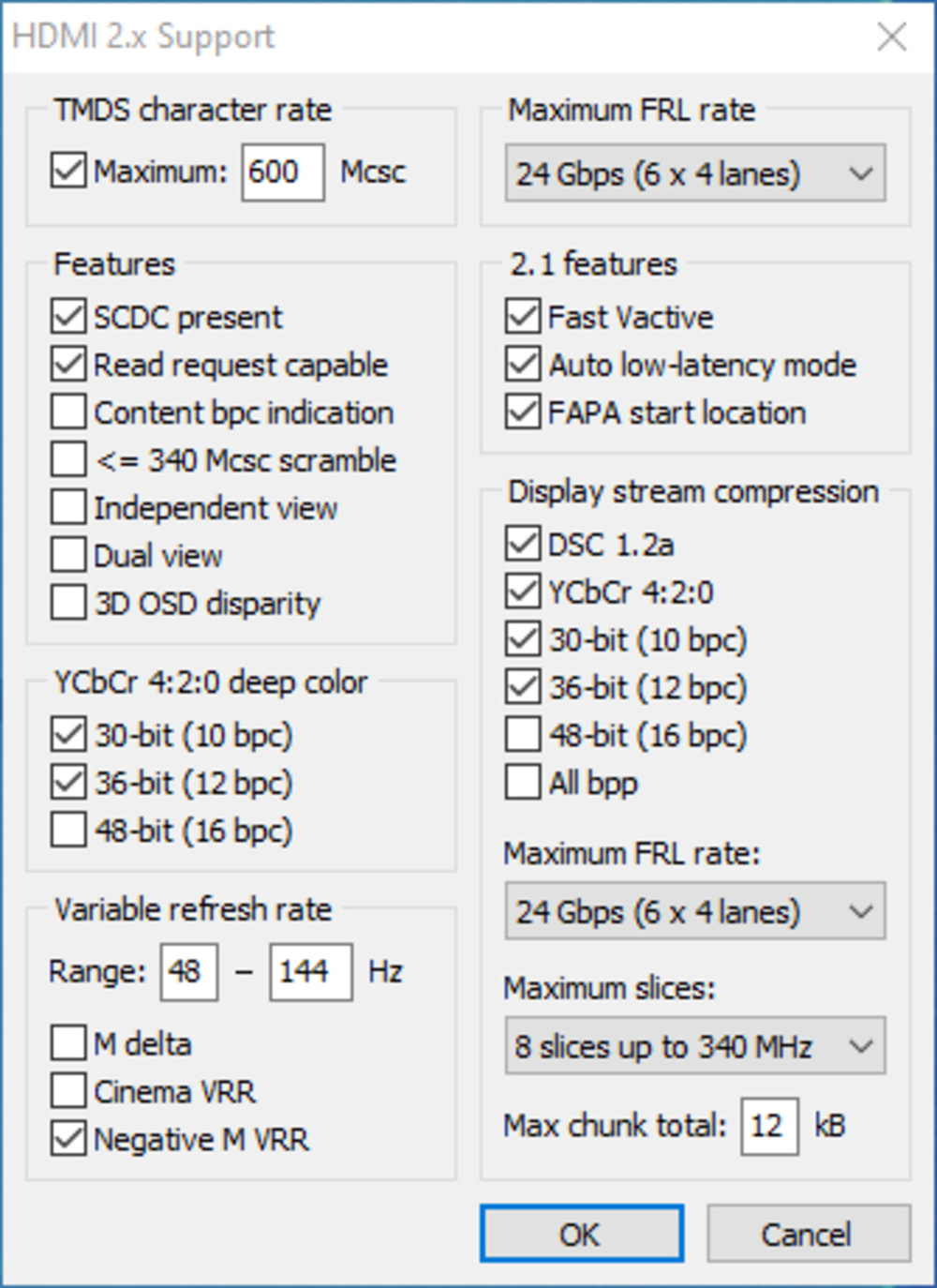- Table of Contents
- Intro
- When It Matters
- Main Features
- FAQ
- Fake HDMI 2.1
- HDMI 2.2
- Conclusion
- Comments
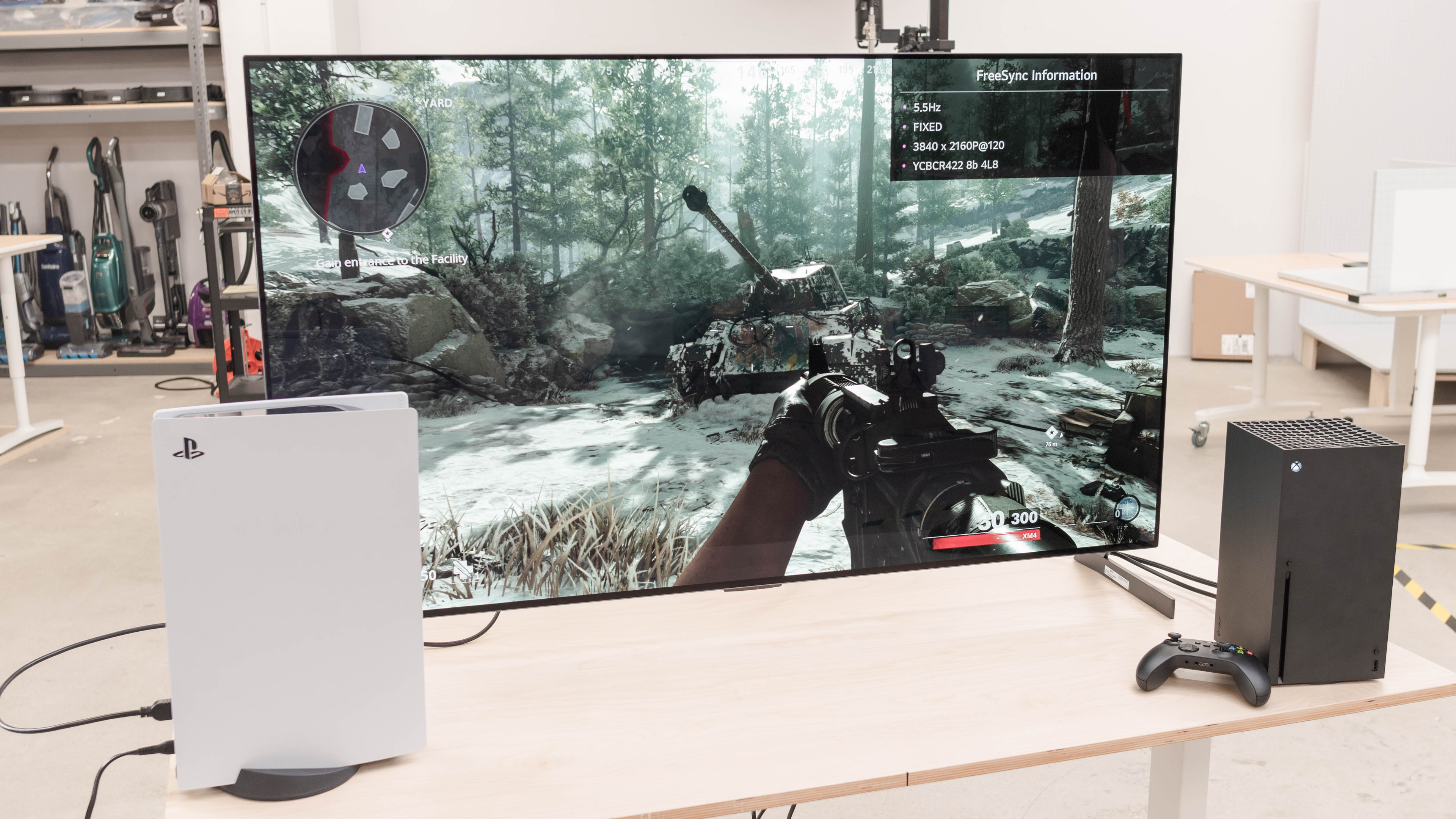
HDMI 2.1 is arguably one of the most significant upgrades to the HDMI standard. Originally announced in November 2017, HDMI 2.1 significantly increases HDMI's maximum bandwidth up to 48 gigabits/second (Gbps) and even more when compression is used. Although HDMI 2.1 sources were only recently made available, some TVs have had support for it since 2019. This new format allows HDMI sources to theoretically transmit resolutions as high as 10k @ 120Hz with compression. It also adds many new features, including Dynamic HDR, HDMI Forum VRR, Quick Media Switching, Auto Low Latency Mode, and eARC, just to name a few. The Xbox Series X and the PS5 each have HDMI 2.1 support, allowing them to transmit 4k content up to 120 frames per second, while the PS4 and Xbox One X had a max frame rate of 60fps with 4k games; this allows for smoother gameplay.
Test results
When It Matters
There are still only a few HDMI 2.1 sources currently available, including the Xbox Series X, PS5, and some graphics cards like the NVIDIA RTX 3080. To take full advantage of a device's capabilities, you also need a TV that supports HDMI 2.1; otherwise, you can't achieve the device's full capability. Some TVs had HDMI 2.1 support even before there were any HDMI 2.1 sources available, including 2019 LG models like the LG B9 OLED, and other companies added HDMI 2.1 inputs with their 2020 models. While some of the features can improve the viewing experience with regular content, the higher bandwidth and new features are especially useful for gaming or higher-resolution displays with faster refresh rates.
Main Features
HDMI 2.1 is a significant upgrade from the older HDMI 2.0. It adds many new features and increases the maximum bandwidth an HDMI cable can support, from 18 Gbps to 48 Gbps. Below is a list of the main consumer-oriented features of HDMI 2.1.
More Bandwidth
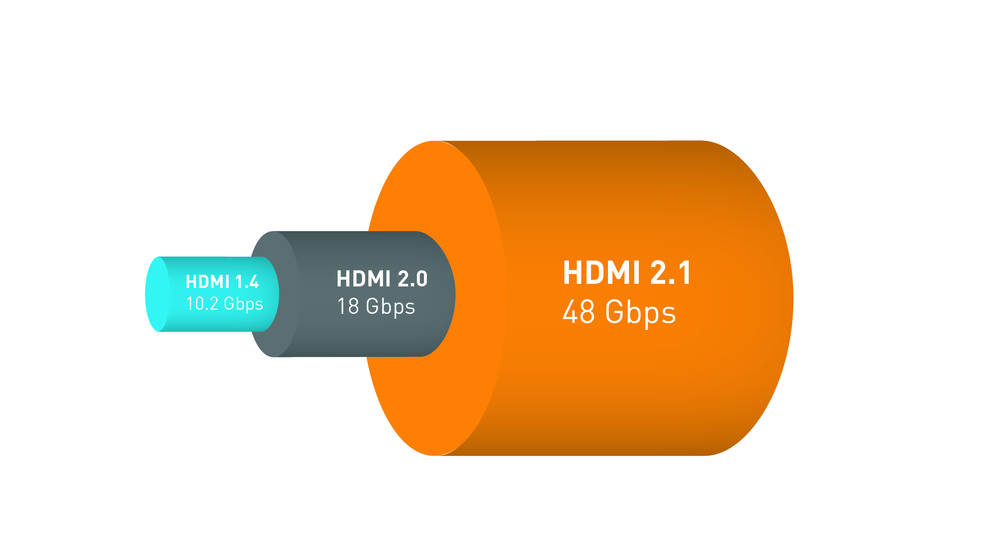
HDMI 2.1 increases the maximum uncompressed bandwidth that an HDMI cable can handle up to 48 Gbps and the maximum compressed bandwidth to at least 128 Gbps. While this is the maximum bandwidth the cable can handle, it may be some time before devices need that much bandwidth, and manufacturers can create TVs that support less bandwidth. For example, if a TV manufacturer only wishes to support 4k @ 120Hz, with 4:2:0 chroma subsampling, then they only need to support about 32 Gbps, and it can still be considered an HDMI 2.1 device. This gives manufacturers significantly more flexibility and allows them to save costs, as they don't need to implement support for the extra bandwidth that the device can't use: a 4k TV doesn't need 8k bandwidth.
Also, an HDMI 2.1 TV doesn't need to support all of its features. This could also make things a bit more complicated for consumers, as it's important to verify the capabilities of every new display to make sure it can support enough bandwidth for the planned usage.
New Supported Resolutions and Faster Refresh Rates
The increased bandwidth supported by HDMI 2.1 allows TV manufacturers to release new devices with resolutions as high as 10k (10420x4320). It's not likely that displays with these ultra-high resolutions will be available on the market for many years. However, the main advantage of having HDMI 2.1 support on a 4k TV is that it can support 4k @ 120Hz content, which is what the newer gaming consoles output.
The following table covers most of the new resolutions and refresh rates permitted by HDMI 2.1. Note that the 'Speed' column refers to the cable type, where 'Premium' has a maximum bandwidth of 18 Gbps, and 'Ultra High Speed' cables have a maximum bandwidth of 48 Gbps, which is what's required for full HDMI 2.1 bandwidth.
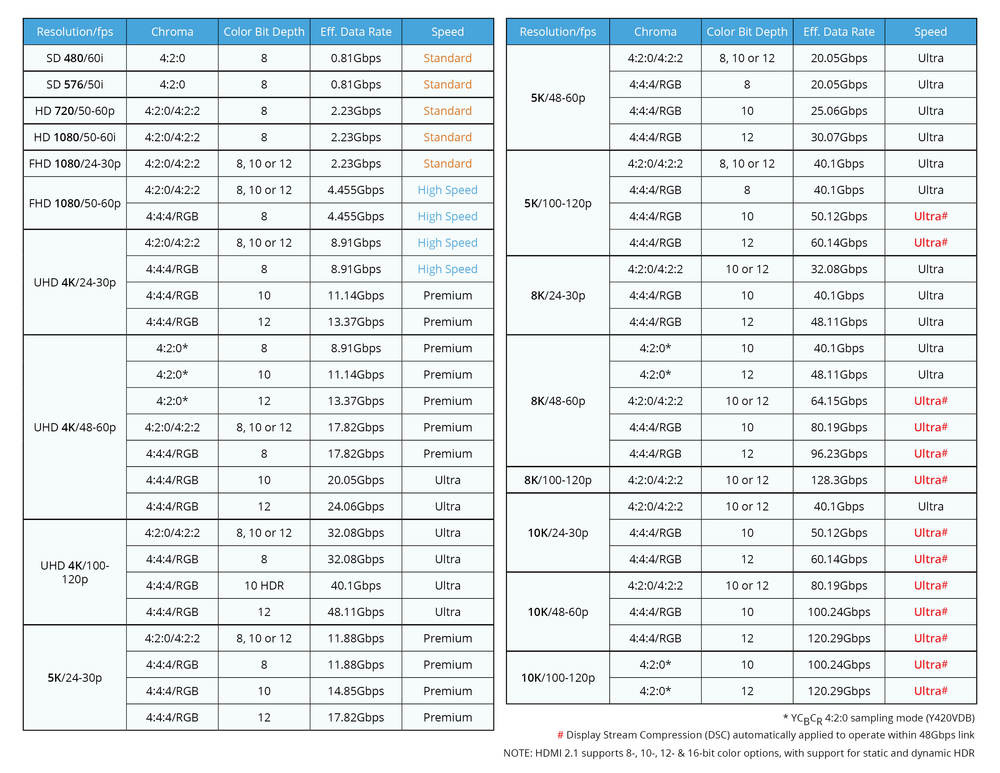
Dynamic HDR
Similar to other dynamic HDR technologies, like Dolby Vision and HDR 10+, HDMI Dynamic HDR allows content to set the dynamic range on a per-scene basis or even frame-by-frame. This allows the TV to read every scene and provide greater depth, detail, contrast, and brightness. We don't yet know how well this technology performs, or how similar it is to the other dynamic HDR formats. Like any new format, until there is content designed for it, we won't know for sure.
HDMI Forum Variable Refresh Rate (VRR)
Like AMD's FreeSync or NVIDIA's G-SYNC, the HDMI group has created its own version of the VESA Adaptive Sync protocol, called HDMI Forum VRR. It's a VRR format that seems to only work with HDMI 2.1 sources, and the Xbox Series X currently supports it alongside its FreeSync VRR support. The PS5 should also receive HDMI Forum VRR support in a future firmware update. Note that not all HDMI 2.1 TVs support HDMI Forum VRR, as is the case with the LG UN8500.
Regarding testing, it may be hard to know exactly if a TV has proper HDMI Forum VRR. Since the Xbox One X/S and Xbox Series X each support HDMI Forum VRR and FreeSync, we don't know for certain which format is working on the TV. Once the PS5 gets HDMI Forum VRR support, it'll be easier to know since the console doesn't support FreeSync.
Auto Low Latency Mode (ALLM)
Another great feature created with gamers in mind, Auto Low Latency Mode (ALLM), allows supported TVs to automatically enable the TV's low latency 'Game' mode when it detects a game launched from a compatible device. This saves you the hassle of having to manually enable 'Game' mode or change the picture mode to 'Game.' It even knows the difference between playing a game, watching a game on YouTube, or watching a movie, automatically switching as needed. Although some Sony TVs have a Sony-specific feature to put it into 'Game' mode when a PlayStation is connected, it's not officially considered ALLM because it doesn't work with any other device. Lastly, you can find this feature on HDMI 2.0 TVs, like the Samsung TU8000.
Quick Media Switching (QMS)
In the past, whenever your device changed the parameters of the signal it was sending or when you changed picture modes, the screen would go black for a few seconds while the TV adjusted to the new signal. This would be especially noticeable on game consoles, where the output refresh rate and even the resolution would sometimes change depending on the content. Quick Media Switching (QMS) fixes this issue. When a compatible source is connected to a compatible display, the TV no longer displays a black screen when switching formats; instead, it instantly switches between modes with no distracting black screen.
Quick Frame Transport (QFT)
Quick Frame Transport (QFT) changes the way images are transferred from a source device to a display. Frames are transferred at a much higher rate to reduce latency. Total input lag is a measure of many factors, including the time it takes the display to process the image and display it on screen. QFT won't eliminate input lag, but it should reduce the lag caused by the transfer time between the source and the display.
Enhanced Audio Return Channel (eARC)
The Audio Return Channel, or ARC, has been a part of the HDMI standard since version 1.4. ARC allows you to connect all your devices (Blu-ray, game console, etc.) directly to either your TV or the receiver and have a single HDMI cable connecting to the other device. This enables bi-directional communication between your receiver and TV; audio is sent from the TV to the receiver, or the receiver sends video back to the TV, with only one cable. This is great for a wall-mounted TV as it helps keep your setup clean.
The current implementation of ARC has some limitations, though; the low bandwidth (~1 Mbps) limits the quality of the audio that can be sent over the return channel, making it impossible to send high-quality, uncompressed audio to your receiver. eARC solves these issues as long as you have a compatible receiver. It vastly increases the amount of bandwidth that the ARC channel can use, up to an impressive 37 Mbps. This extra bandwidth makes it possible to send uncompressed 5.1 and 7.1 audio, like Dolby TrueHD and DTS-HD MA, which are often the carrier signals for Dolby Atmos and DTS:X.
HDMI Cable power
With the release of HDMI 2.1, there's a new HDMI cable labeled as 'Ultra High Speed,' which allows the source to transmit up to 48Gbps. This is an upgrade from the 'Premium ' cable that's used with HDMI 2.0 sources to support up to 18Gbps. Due to the high performance requirements, the cable may need to receive extra power to work properly, and the new HDMI Cable Power feature allows for that. This extra power is only required in longer cables, so you may not need it with a short cable, and it's likely needed in more business or commercial setups.
When using this feature, there's only one correct way to connect the HDMI cable between the source and the display, and it's properly marked on the cable. If it's reversed, the HDMI Cable Power feature simply won't work and it won't transmit its maximum bandwidth.
Display Stream Compression 1.2
With HDMI 2.1's new, higher bandwidth requirements, new methods of compression are required. The most common method of compressing video streams is a technology called Display Stream Compression (DSC). It was initially developed with computers in mind and couldn't encode most TV signals efficiently. The VESA group responsible for maintaining DSC released an updated version of DSC, known as DSC 1.2, which increases the maximum color depth to 16-bit and enables native YCbCr 4:2:0 and YCbCr 4:2:2 encoding without the need to convert to RGB first.
This technology, which is supported by HDMI 2.1 but not necessarily by all devices that support HDMI 2.1, drastically increases the maximum bandwidth that HDMI cables can transmit without compromising image quality. DSC is only required for very high resolution, high refresh rate devices, and it may be many years before it's needed.
Frequently Asked Questions
Q: Which devices will support it?
A: As of 2021, only the Xbox Series X and PS5, as well as some graphics cards, support HDMI 2.1. Since this format is aimed at gaming, it's unlikely that most everyday devices, like streaming devices and cable boxes, will ever support HDMI 2.1, as HDMI 2.1 offers no real benefit for these devices. As for Blu-ray players, HDMI 2.0 has enough bandwidth to support 8k @ 24Hz with an 8-bit signal instead of 10-bit, so it may be a while before we see Blu-ray players with HDMI 2.1 support; however, they'll likely be needed for 8k HDR content, whenever that becomes available.
Q: How do I know if my TV supports HDMI 2.1?
A: It should be easy to find if your TV has HDMI 2.1 inputs. You can simply check the back of the TV to see what's written above the HDMI inputs. Although some inputs won't specifically say 'HDMI 2.1', the TV may show the maximum refresh rate at 4k; an HDMI 2.0 input shows '4k @ 60Hz', while an HDMI 2.1 input shows '4k @ 120Hz' and may also have an eARC label. You can see the differences below.
If it's not properly indicated on the labels, you can check the TV's specifications to see which aspects of HDMI 2.1 the TV supports. However, there are some limits to this; see "Fake HDMI 2.1" below.
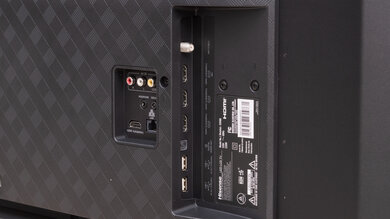
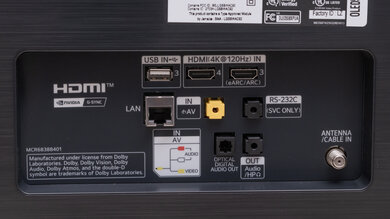
Q: My device supports features from HDMI 2.1. Does that mean it supports HDMI 2.1?
A: Not necessarily. One of the interesting changes is that, for the first time, manufacturers can choose to implement some features of HDMI 2.1 in HDMI 2.0, including VRR and ALLM, as these features require very little additional bandwidth. Devices that support these features, including the Samsung Q60/Q60T QLED, the TCL 6 Series/S635 2020 QLED, and the Xbox One S/X, aren't HDMI 2.1 devices, but they merely implement some features from 2.1.
Another example is eARC, which can be added to almost any HDMI 2.0 device with a firmware update. Some HDMI 2.0 TVs have eARC support, including the entry-level Vizio V Series 2020. Once again, these devices support features from HDMI 2.1 but aren't HDMI 2.1 sources.
Q: Will I need to upgrade my cables?
A: It depends on what you want to do. The new Ultra High Speed cable uses the same physical layout and connector as existing HDMI Premium High Speed cables. Except for eARC, which requires a Premium High Speed + Ethernet cable, most of the other new features can be implemented on existing devices with existing cables. However, if you want to take advantage of any of the new resolutions or higher refresh rates, you eventually need to upgrade your cables.
It's important to note that the cables themselves aren't tied to a specific version. There's no such thing as an HDMI 2.0 cable or an HDMI 2.1 cable. Instead, cables are put through a certification process that certifies them for certain maximum bandwidths. HDMI 2.0 generally requires a maximum bandwidth of 18Gbps, and cables that have been certified for that are labeled 'Premium.' The new cables that are certified for HDMI 2.1's maximum bandwidth of 48Gbps are labeled as 'Ultra High Speed.' This doesn't mean that a 'Premium' cable can't be used with an HDMI 2.1 device, merely that it hasn't been certified for the extra bandwidth. The same goes the other way around, as you can easily use the Ultra High Speed cable on any older HDMI device.
Q: Can my existing devices be upgraded?
A: It depends. The higher bandwidth of HDMI 2.1 requires more advanced processors on the display, so it's unlikely that any existing display will be able to support higher resolutions or refresh rates if they only have HDMI 2.0 support. On the other hand, most of the additional features, like eARC and ALLM, require very little additional bandwidth. Although they require fairly significant firmware changes, it's possible to implement them on existing devices. Regarding eARC, specifically, multiple HDMI 2.0 TVs already support it.
Q: How do I know how much bandwidth my device supports?
If you're unsure which formats your display supports, there's a free Windows utility known as Custom Resolution Utility (CRU) that can help. This utility works with both NVIDIA and AMD graphics cards. It can show you helpful information about the capabilities of your connected displays, including which resolutions they support and the maximum bandwidth of their ports.
For HDMI 2.1 devices, you want to look at the Maximum FRL rate. This is the maximum bandwidth reported by the TV or monitor.
"Fake" HDMI 2.1
Some manufacturers have started claiming that their TVs support HDMI 2.1 while only supporting a few features of HDMI 2.1, or in some cases, none at all. As reported by TFT Central, this is due to a change by the HDMI licensing board, which essentially deprecates the HDMI 2.0 standard in favor of HDMI 2.1. With this change, since HDMI 2.1 is fully backward compatible with HDMI 2.0, manufacturers can claim that their devices meet the HDMI 2.1 specifications without actually supporting anything new.
This is, of course, highly confusing for consumers. It's no longer possible to infer which features a device supports simply by the HDMI port specification; we instead have to dig deeper and hope that the manufacturer is transparent about which features their display supports. In our reviews, we only consider a device to be "HDMI 2.1 Class" if it supports bandwidth beyond the limitations of HDMI 2.0. Since features like eARC and VRR don't require any extra bandwidth, if a TV only supports those features, we consider it HDMI 2.0, even if the official certification has been retired.
This also applies to monitors. We only consider a monitor to have HDMI 2.1 ports if those ports support higher bandwidth formats over HDMI. For example, if a monitor supports 4k @ 60Hz with a 10-bit, 4:4:4 signal, it's HDMI 2.1. HDMI 2.1 ports can support different maximum bandwidths, but as long as they support more than the 18Gbps limit of HDMI 2.0, we consider them HDMI 2.1 ports.
HDMI 2.2
On January 6, 2025, the HDMI Forum group officially unveiled the next revision of the HDMI specification, HDMI 2.2. This new format increases the maximum bandwidth supported by HDMI to 96Gbps. This increase in bandwidth allows for resolutions up to 16k, although the exact specifications haven't been announced yet. This new revision isn't just about increased bandwidth, though. HDMI 2.2 also adds a new latency protocol called Latency Indication Protocol (LIP). This new feature should improve audio/video synchronization, which is a common pain point when connecting TVs to home audio/video receivers or soundbars.
None of the new TVs announced for 2025 support this new format, but new cables have already been shown and should be hitting stores soon. You can identify certified cables by the "Ultra96" branding.
Conclusion
HDMI 2.1 is a significant upgrade over HDMI 2.0. To take full advantage of its features, you need devices and a display that each supports it; otherwise, you may lose out on some features. There are already a few TVs with HDMI 2.1 support, and the new gaming consoles also support it. This new HDMI format allows for higher resolutions and frame rates, which help deliver a smoother, more immersive gaming experience. However, if you're not a gamer, it's unlikely you'll need an HDMI 2.1 TV anytime soon.
